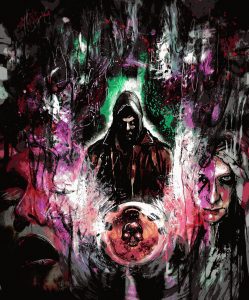Article written by Casvar Quivian, as provided by Sam Jowett
Art by Luke Spooner
Introduction
Call this a tell-all, call this an indictment.
For myself, it is a revelation.
This will be my final paper on Final Blush of the Republic. There’s no doubt some of you are gasping with relief at the reading of those words, but it’s only for the sole reason that there will cease to be the need for any further papers. Even that ghoul Temyren from the History Department is waving in the white flag after I’m finished, which is truly the real blessing. Regardless, the debate ends here.
Orin Sydan’s work of Final Blush of the Republic can be considered nothing short of a masterpiece. Composed brilliantly in the final days of the Cantarin Democratic Electorate of Niser, it is more than the tipping point of the political turmoil that had encompassed the State at that time, it’s the abolishment of that tumour of faux democracy that we had been subject to live in for the last two centuries.
The composition occurred on the 30th of June 2527, at approximately 3:12 in the afternoon. Given the unpredictable nature of its subjects, many–truly it is embarrassing that Temyren’s “paper” on the subject even got him tenure–attribute Sydan’s composition to pure luck. To do so, I insist, would be a mistake, as they miss the essential preparations Sydan endured for what is estimated to be over two years, before composing the work.
Can Temyren truly dismiss it as luck that Final Blush of the Republic was composed in the formal Executive House of the Cantarin Political Party? Was it luck that the fifteen subjects included most of the essential government characters of that term? Was it luck that the colours remained thick and all encompassing throughout the piece? None of the ultramarine blue that represented the Cantarin Elect remained; replacing them were vivid shades of coral, pink, vermillion, and scarlet. I could perhaps entertain a grain of serendipity to the proceedings, but credit ought to go where credit is due, and by all accounts, Sydan is a genius.
To read the rest of this story, check out the Mad Scientist Journal: Summer 2017 collection.
Casvar Quivian is an associate professor in the Critical Art studies department at Niser University. He has published several papers on the emergence and cultural relevance of Chem-Art, hoping to end its stigmatization and promote a sort of “open-mindedness” on the subject. This has led to more than a few heated debates with other members of faculty, a few of which leading to physical altercations, one of which includes a notorious charge of assault involving a Holo-board. The official position of Niser University is to remain neutral in the debate, but to encourage a plurality of opinions and conflict resolutions on the subject.
Sam Jowett currently lives and studies law in Toronto, Ontario. While he should perhaps focus on writing more “academic things,” he can’t help but procrastinate and write “fiction things” instead. You can find his stories at Fickle Muses and Storyshack.
Luke Spooner, a.k.a. ‘Carrion House,’ currently lives and works in the South of England. Having recently graduated from the University of Portsmouth with a first class degree, he is now a full time illustrator for just about any project that piques his interest. Despite regular forays into children’s books and fairy tales, his true love lies in anything macabre, melancholy, or dark in nature and essence. He believes that the job of putting someone else’s words into a visual form, to accompany and support their text, is a massive responsibility, as well as being something he truly treasures. You can visit his web site at www.carrionhouse.com.
“The Origins of Chem-Art: A Look into the Manifestation of ‘Final Blush of the Republic'” is © 2017 Sam Jowett
Art accompanying story is © 2017 Luke Spooner

